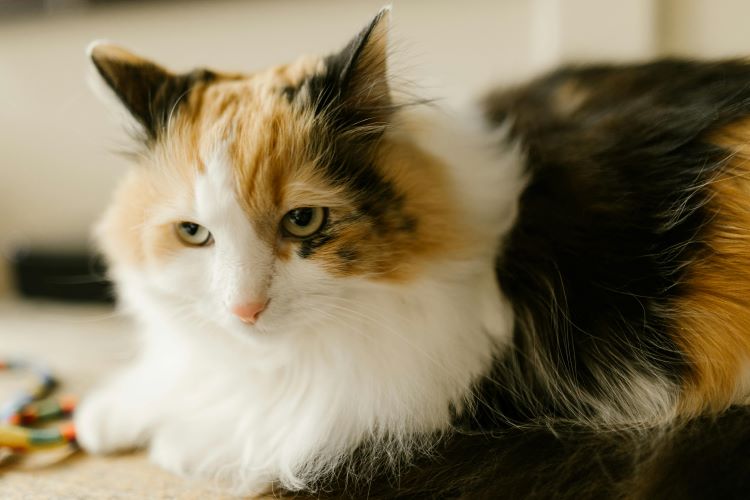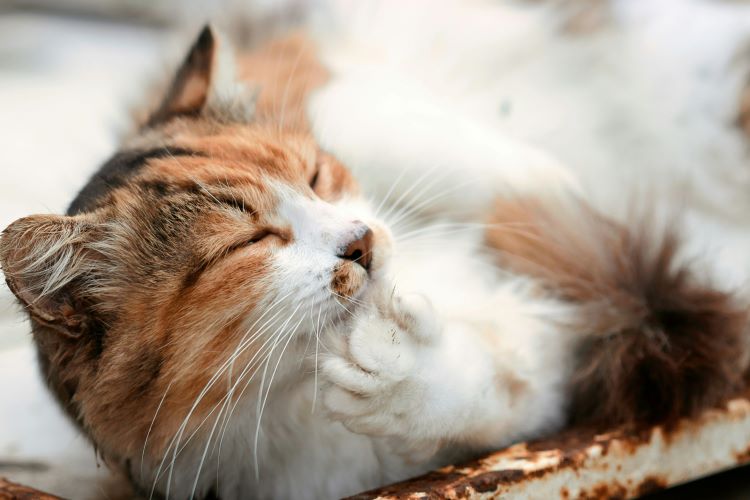Ready to help treat your pet to a healthy life?
What is a Klinefelter Cat? Understanding a Feline Phenomenon
By : Brianna Gunter | Published Sep 10, 2024

“This little lady is a calico cat. All calico cats are female.”
Fans of the TV show It’s Always Sunny in Philadelphia may recognize this bit of wisdom as a quote from Charlie Kelly, a character obsessed with cats. But while Charlie tends to spout a lot of misconceptions about his favorite animal, it turns out he’s right with this one. Well, kind of.
If you’re looking at your own male calico (that is, a cat with tri-colored fur) right now and scratching your head, don’t worry — there is an explanation. Here at Trupanion’s Pet Parenting, we’re also cat-obsessed, though unlike Charlie we do our research and consult with our staff veterinarians and vet techs.
The truth is that most calico cats are female. There are rare exceptions, and these special guys are known as Klinefelter cats. In order to recognize just how unique these colorful kitties are, we’ll have to dive into feline genetics.
What makes a Klinefelter cat?
A Klinefelter cat is a rare and interesting phenomenon in the feline world, named after Klinefelter syndrome, a chromosomal condition in humans. But unlike with the human condition, the term "Klinefelter cat" is used colloquially and isn't a scientific designation. It simply refers to male cats that possess an extra X chromosome in their genetic makeup.
Here’s where understanding cat genetics becomes important, particularly in how sex chromosomes work. In most mammals, including cats, sex is determined by the combination of two identifying chromosomes: X and Y. Typically, female cats have two X chromosomes (XX), while male cats have one X and one Y chromosome (XY).
In rare cases, however, a male cat may inherit an extra X chromosome, resulting in an XXY configuration. This genetic anomaly occurs thanks to what’s called a “nondisjunction event,” in which chromosomes fail to separate properly during meiosis, the cell division that produces gametes (reproductive or “sex cells” a.k.a. sperm and egg cells). As a result, an egg or sperm cell may end up with an extra X chromosome. When this goes on to combine with a normal gamete from the other parent during feline reproduction, the result is offspring with an XXY chromosome pattern — a Klinefelter kitten!
So, what does this mean for said kitten? The presence of the extra X chromosome can lead to a range of physical and behavioral characteristics that are atypical for male cats. We’ll get more into these characteristics in just a bit, but it’s worth noting that it’s the additional X chromosome alone that makes a cat “Klinefelter.” Furthermore, these cats are still typically considered male thanks to their Y chromosome.
Where does calico fur come in?
One of the most fascinating aspects of Klinefelter cats is that they are almost always tortoiseshell or calico in color. This is because the genes that determine the orange and black fur colors in cats are located on the X chromosome. In female cats (XX), one of the X chromosomes in each cell is randomly inactivated, leading to the patchy orange and black fur that is characteristic of tortoiseshell and calico cats.
Since male cats typically have only one X chromosome, they usually don't display this coloration unless they possess an extra X chromosome, as seen in Klinefelter cats.
Does this mean all male calicos are Klinefelter cats?
Yes… and no. In order for a true male calico or tortoiseshell cat to exist, they will need an extra X chromosome. However, there are some male cats who may appear to be calico but just have darker toned fur in certain areas that isn’t actually a separate color of its own.

Physical and behavioral characteristics
It’s not just about colors and fur patterns! Klinefelter cats, like their human counterparts with Klinefelter syndrome, can exhibit a range of other physical as well as behavioral traits that distinguish them from other male cats. Even so, Klinefelter kitties are often still unique as individuals and display differences from one another both in appearance and in personality. They can come in long, short, and medium fur varieties, for instance, and some are very friendly while others are more shy and reserved.
Nevertheless, some of the common characteristics of Klinefelter cats include:
Tortoiseshell or calico coat
As explained earlier, Klinefelter cats are often tortoiseshell or calico, a coloration usually exclusive to female cats. The presence of both orange and black fur in males is a key indicator of the XXY chromosome pattern.
Sterility
Klinefelter cats are almost always sterile due to their abnormal chromosome count. This means that while they may exhibit typical male behaviors such as spraying or mounting, they are generally unable to father kittens. According to some sources, as few as one in 10,000 Klinefelter cats are not sterile.
While this may seem like a shame if you have a male calico (they’re cute!), keep in mind that the average household cat is neutered/spayed anyway. And even if your Klinefelter kitty is not yet neutered, your veterinarian may recommend it regardless in order to reduce certain cancer risks.
Softer appearance
Klinefelter cats may have an appearance more associated with female cats compared to typical males. They might have a more rounded face, softer features, and less pronounced jowls. Their body size may likewise be smaller or less muscular than that of a standard male cat. If they come from bigger cat breeds, they may still appear to be on the larger size compared to the average domestic cat but will likely be smaller than others cats of similar ancestry. For example, Klinefelter Maine Coons exist.
Health issues
As majestic as they are in appearance, Klinefelter cats may be more prone to certain health problems. While more research is needed in this area, they are believed to have a higher risk of developing diabetes, urinary tract infections, or skeletal issues due to their unusual genetic makeup.
If you have a male calico or known Klinefelter cat, this doesn’t mean your pet is guaranteed to have health issues! Not all Klinefelter felines will experience these health problems, and many live long, healthy lives. That said, it is still a good idea to protect your pet from unexpected health conditions with cat insurance. It should also go without saying that routine veterinary checkups are a must.
Affectionate behavior
While there is limited research on the behavioral traits of Klinefelter cats, some owners report that these cats tend to be more docile and affectionate than typical male cats. They may also exhibit less territorial aggression, possibly due to their altered hormone levels.
Diagnosis and care
Formally diagnosing a Klinefelter cat can be pretty tricky because it requires genetic testing to confirm the additional X chromosome. That said, if a male cat exhibits tortoiseshell or calico coloring along with traits commonly associated with the condition, it’s highly likely that the cat is a Klinefelter. When formally diagnosed, it is sometimes called “genetic mosaicism,” but this can refer to a range of chromosomal anomalies, not just the XXY lineup.
Getting a genetic test done to confirm it can be beneficial for the cat in terms of the pet owner (and veterinarian) being aware of potential increased risk for certain health conditions. Nevertheless, caring for a Klinefelter cat is essentially no different from caring for any other cat. We’ve already mentioned this, but staying on top of routine veterinary care is essential.

How rare are Klinefelter cats?
The prevalence of XXY cats may be up for some debate, as many Klinefelter felines live their entire lives without getting formally diagnosed (more on this in a moment). That said, the genetic phenomenon that needs to occur in order for them to exist still makes these cats incredibly rare. And since the majority of them are sterile, their genes do not get passed on to produce further Klinefelter kitties.
According to a study by the College of Veterinary Medicine at the University of Missouri, only one out of every 3,000 male cats is a Klinefelter.
So, if you happen to have one of your own, just know that they truly are one of a kind! If anything, their existence is a reminder of the incredible diversity and complexity found among cats, and in nature as a whole.
Like learning about different types of felines? Find out what a cobby cat is.
